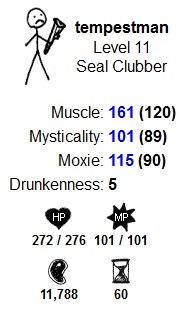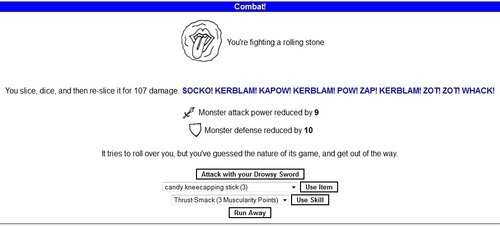 |
| Tiamat, Queen of the Dragons | Image Courtesy of Enworld |
I know it's been awhile since I last reviewed a game, so I figured I would do something new with this post- review a table-top role playing game. Now, for those of you unfamiliar with TTRPGs (which given the nature of this blog and the audience it would attract if it indeed attracted an audience is pretty slim), they are games wherein a group of people, usually ranging from 3-6, come together and use a set of rules to tell a story together. Each game usually has a Dungeon Master (or Game Master) that works on the general frame of the story and presents challenges to the players, and 2-5 players that creature characters that interact with the world the DM has created. Together they tell a story, usually one that isn't even remotely close to the one the DM wanted to tell (I'm looking at your RYAN!).
Even those unfamiliar with how a table-top role-playing game works probably still know what Dungeons and Dragons is, or have at least heard of it. After all, the game has the brand recognition that few others can match. It's left as much an impact, if not a great impact, in our collective conscious as Pikachu and Mario.
 |
| Here we have a Lv 9 Human Monk fighting a Dire Rat blessed by Thor. | Image Courtesy of The Mushroom Kingdom |
Now Dungeons and Dragons (or D&D as it is more commonly called), has gone through many different versions, known as editions. It started out with Gary Gygax and Dave Arneson's original version of Dungeons and Dragons, which was published in 1974, and underwent several changes including Basic Dungeons and Dragons, Advanced Dungeons and Dragons, Advanced Dungeons and Dragons 2nd Edition, Dungeons and Dragons 3.0 (and later 3.5), Dungeons and Dragons 4th Edition, Pathfinder (it's D&D and we all know it), and finally Dungeons and Dragons 5th Edition. Many other games that were inspired by D&D or designed to play with a similar feel were also created, such as Pelgrane Press' 13th Age.
But now that we're done linking to a bunch of Wikipedia pages, let's get down to business with this article before you all close your browsers and move on to 4chan and Reddit to complain about Gamergate (Ha! A timely cultural reference from a blogger that only posts once every two years! That'll sure date this article in three years when it's finally read!).
Alright, seriously, we're going to buckle down now and actually review Dungeons and Dragons 5th Edition. Now I've been playing D&D since I was sixteen when none other than Cameron Lawrence himself invited me to join his game of D&D (3.5). One cringe-worthy backstory later and I was Ashiel Dragmire, half-elven sorcerer sent on a quest to recover some hobbit's treasure or something like that.
 |
| This? I'm pretty sure it was this. | Image Courtesy of G4TV.com |
Anyway, it only took about five minutes before I was in love. I spent the ensuring seven years learning everything I could about D&D- the mechanics, the lore, how to optimize my own characters while simultaneously learning how to beat down players who tried to break my games with their own over-powered characters. I observed Cameron's DM style, as well as the style of our other DM Nate, and tweaked them to create my own way of running games. As a writer by hobby (and hopefully one day by trade so I can plug articles like this with links to my work), I wasn't worried about telling a story. I had countless worlds floating around in my head and it wasn't hard to slap some mechanics to them and set my players loose.
Eventually I moved to college and met a new gaming group and picked up on how to play Pathfinder, which wasn't so different than D&D 3.5. I never got into 4th Edition, mostly because I missed the session that my original gaming group used to test it (they weren't the biggest fans) and my new group's DM had an absolute loathing of it. I played that for several years before finally joining the Dungeons and Dragons Next playtest. My buddy Ryan and I created characters (I was, and continue to be, a human rogue while he plays a paladin of Wee Jas) and drove three hours to Scranton, PA for MEPACon, which if you're in the Pennsylvania area I highly recommend going to. Affordable, some great people there, and all-in-all it's a lot of fun.
 |
| YOUNG MAN YOU WILL STOP PLUGGING AND LINKING AND START REVIEWING! | Image Courtesy of Jesus-Is-Savior.com |
So Ryan and I had our freshly-rolled characters and a set of rules that at many points seemed very contradictory, but hey, it was a playtest so we understood. Once we got to playing we found the game to be a little slow and clunky in places. The DMs at the convention had us take notes about their adventures and the mechanics in general after each 4-hour gaming slot, and when we returned next fall we were given packets with several updates that made for a smoother, more fluid game. Some old things we liked were taken out, but several newer and better mechanics were added in. It continued on like this until finally the playtest was closed. The long wait for the Player's Handbook began...
When the Player's Handbook finally hit the shelves I bought a copy and poured over it. I was immediately in love. All the things that I liked from the playtest were there (somethings were nerfed a little more than I liked, but I wasn't about to get all up in arms on the Internet about it. Wait...) and several new mechanics I wouldn't have even thought of were added in. At a glance the classes and races appeared rather well-balanced, and several new backgrounds were added in to provide even more options for players.
The Races
 |
| The Tiefling, a personal favorite of mine and a welcome addition to the PHB | Image Courtesy of Enworld |
There are four "core" races in D&D 5e: Dwarves, Elves, Halflings, and Humans. These represent the four main races that can be found in just about any published Dungeons and Dragons setting without standing out. Each of the non-human races has at least two sub-race options, allowing players to further customize their character within its race. For example, a dwarf can either be a hardier hill dwarf, or a stronger mountain dwarf while an elf can either be a magical high elf, wilderness-savvy wood elf, or vile drow. Humans have the option of using a variant human rule that makes them more akin to 3.X's human race, giving them a free bonus feat and two skill proficiencies at the cost of reduced ability score bonuses. It's probably the best race option in the game, as feats and skills are immensely powerful and important.
In addition to the four core races there are dragonborn (totally different from the character you've played in Skyrim, gnomes, half-elves, half-orcs, and tieflings. They are separated from the other four races as they are treated as "unusual" races that may not be present or appropriate for all games and settings. Due to their more unique natures, these races don't have any sub-race options, at least not in the Player's Handbook.
Overall I was satisfied with the amount of race options in the Player's Handbook. There were more for me to choose from than in the 3.5 or Pathfinder's Player's Guides, which means I have to do less pleading to get my DM to let me play something uncommon like a tiefling or dragonborn.
The Classes
 |
| The Warlock, a unique caster that takes traits from multiple warlock incarnations throughout D&D's history. | Image Courtesy of Enworld |
Next up are the classes. Right away I was impressed with the number of options I had at my disposal. While there was only one "new" class compared to the PHBs I was used to, it just felt like I had a nearly unlimited number of choices- probably the result of the rather limited choices I was left with in the playtest for this edition. I could choose anything from the anger-management needing barbarian to the whimsical bard to the wizened cleric to the hippie druid. I could even be a monk, and more importantly not suck. Yes, the classes were actually balanced!
Well, mostly. So far in my time playing 5e as both a player and a Dungeon Master I've found that spellcasting classes are still a little more powerful than non-casting classes, but it's more due to their increased versatility rather than straight damage. Fighters received a much-needed boost with their Battle Master and Eldritch Knight Specializations, and even monks can use ki to "cast spells." While basically giving everyone the ability to use magic is a cheap way to balance the game, it is effective and so far I haven't felt as if my character can't contribute to the party, nor as a DM have I seen any one class shine brighter than the rest.
The thing I like most about each class is the option to choose between two or three specializations (clerics and wizards have a larger number of domains or schools to choose from, but the differences are more subtle). Much like Pathfinder's Archetypes and 3.X's Alternative Class Features, a specialization allows you to narrow your character's focus and give them some cool abilities that not all members of their class might have. For example, as a rogue you can be a guild thief, an assassin, or an arcane trickster. As a thief you become more mobile and stealthy, making it easier to sneak up on others and rob them blind as well as survive in dungeons. Assassins gain the ability to blend in with the crowd and a powerful death attack that allows them to deal even more sneak attack damage (which has been greatly boosted in this edition of Dungeons and Dragons). Finally, arcane tricksters learn how to cast a few spells and use them in unusual ways to gain an edge in combat.
The specializations aren't quite as balanced as the classes, and it's pretty clear which specializations are superior to others (I'm looking at you Champion. God you were a disappointment.). While it's a shame that the same amount of effort wasn't put into the specializations as the classes themselves, I don't think it'll ruin the game in the long-run. Each class has at least two specializations that are viable. Hopefully when the Dungeon Master's Guide is released it will come with some new specializations for those classes who don't have as many (*cough cough* sorcerer and barbarian *cough cough*).
The Backgrounds
 |
| The Soldier Background, a common choice amongst Fighters, or so I have found. | Image Courtesy of Enworld |
While I was originally going to review all of the 5th Edition material I've encountered so far in this article, I'm already at 1,723 words (not including captions!), so I'll wrap up after this section. Backgrounds were not something I expected from Dungeons and Dragons, but boy am I ever glad to see them! They're a great tool for new and veteran gamers alike, making it easier for neophyte dungeon delvers to flesh out their characters beyond "I'm a fighter with a sword and I like to kill things, drink ale, collect gold, and make love to beautiful women."
 |
| Not that there is anything wrong with that! | Image Courtesy of Collider.com |
There are several backgrounds ranging from the Soldier pictured above to the acolyte of the faith to the sly charlatan to the rugged outlander. Each background provides several proficiencies, either in skills or tools, additional gear that might come in handy in your adventures, and a unique ability that, while rarely provides a mechanical benefit, has a nice role-playing ability or hook. For instance, a folk hero can more easily find shelter amongst the common people. There is no mechanical benefit (he doesn't get a +2 to the roll or gain advantage), the DM and the player role-play the encounter between the player's character and the smallfolk whose aid he is trying to gain.
Many of the background also have an alternate background option, such as the guild merchant option for the guild artisan background. The alternate option might have a slightly different set of proficiencies and different fluff, but it is too similar to the base background to warrant being an independent background choice. While a nice addition to the playtest's set of backgrounds, I didn't feel as if they brought a whole lot to the table (Hell, I was a guild merchant before it was even a thing!). Like with the class specializations, I hope that the Dungeons Master's Guide will come with more backgrounds.
I apologize for not getting around to reviewing more of D&D 5e's many, many options, but I feel like I've already used up enough of your time. Join me next week and we'll look over feats, spells, and the Monster Manual! Now before I go, I'll leave you with this fantastic video. This actually happens every time a game of Dungeons and Dragons is played. Seriously. Every. Time.
You can download the Dungeons and Dragons 5th Edition Basic Rules for free here, courtesy of Wizards of the Coast. Wasn't that nice of them?



 10:48 AM
10:48 AM
 Sean L. McClellan
Sean L. McClellan











